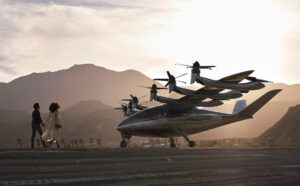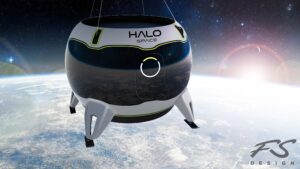Frank Stephenson: ‘The best way to predict the future is to design it’
From iconic supercars to flying spacecraft of the future, Frank Stephenson has designed it all.
His company, Frank Stephenson Design, has a world-class pedigree in the automotive sector, having helped…

From iconic supercars to flying spacecraft of the future, Frank Stephenson has designed it all.
His company, Frank Stephenson Design, has a world-class pedigree in the automotive sector, having helped to shape the look and feel of vehicles from the MINI to Maserati.
But Stephenson is using his wealth of experience to further another industry in the quest for innovation, efficiency, and beauty – and that is the world of aerospace.
Using expertise gained over more than three decades, Stephenson has applied his philosophy to the new breed of electric vertical takeoff and landing (eVTOL) aircraft, as well as spacecraft that could spur on tourism beyond Earth.
As Farnborough International celebrates its 75th birthday, FINN spoke to Stephenson about his legacy, and what the next three-quarters of a century might hold for aircraft design.
‘Everything about aviation interests me’
“Everything about aviation interests me, mostly from a design perspective, but also performance.” Stephenson said.
“When I was growing up, my father worked for Boeing, so I was always near aircraft. He also created an automotive dealership in the mid 1960s, and I was very attached to that as well, so I grew up with a huge interest in transportation and mobility.
“For the last 30-plus years, I’ve mostly been designing cars, from bread-and-butter type, A-to-B cars all the way up to the highest extreme of what we call hyper cars, or very limited edition cars.
“So that range pretty much introduces you to everything that could be a challenge in the automotive industry, whether it’s making a quality global runabout car and all the way to what the most extreme clients would want on a very unique and bespoke vehicle.”
Aerial mobility
In more recent years, Stephenson has turned his attention to the skies.
“Having reached a peak, I wanted to do my own designs for what I think could really bring a big impact to the world of mobility.” he explained. “It was a jump into the unknown because I didn’t know what was out there. I just knew that I wanted to do something that would change the world.”
It was then that Stephenson began working on eVTOLs. From May 2018 to November 2019, he was the creative director at German company Lilium Aviation.
He has since been involved with Archer and was appointed the lead design authority for AutoFlight’s Prosperity 1.
Frank Stephenson Design was tasked with crafting the aircraft’s exterior and interior in an attempt to re-define urban mobility.
Motor industry meets aviation
There is crossover between the motor industry and the aviation industry in terms of propulsion technology, design and testing. But there are also some obvious and major differences, not least the higher safety standards that aerospace regulators demand.
“In aviation, it has to work,” said Stephenson. “Cars can break down and you can get help – cars often do break down. Whereas in the aviation industry, you can’t break down, so the restrictions, the regulations, certification, all of that is a level higher.
“In terms of performance, in the automotive industry weight is the enemy, and we have to control to the maximum amount both aerodynamics and weight. Those relate very closely to the aviation industry, where you have to make sure that weight is minimised in every single component.”
His extensive design know-how is helping define what future aircraft will look like. Stephenson said: “Blended wing is one of the best solutions for aircraft design, you can get a lot more efficiency out of the wing. There may also be short range commercial flights in the next 30 to 50 years, going totally electric and totally autonomous.”
Space exploration
Stephenson’s work on spacecraft is now pushing the boundaries of what can be achieved away from planet Earth.
Frank Stephenson Design has been appointed to lead the design for HALO Spaceflight and has been tasked with creating an immersive capsule experience that will combine comfort and practicality for eight passengers as they journey on a zero-emission, six-hour journey to the edge of space.
“We’ve always looked to the heavens,” he said. “You get astronauts coming back always saying the same thing. The Earth, when you see it from outer space, just changes your mindset.
“At the moment, anybody who goes up to space for a million dollars, pollutes the atmosphere with those rockets – good thing that we’re not sending too many of them up there. It’s not really within the range of a large segment in public to do this anyway.
“What I’m working on is a project that will rise to the upper levels of the stratosphere. It takes two hours to get up to that level, the ascent is about five metres per second, which is not drastic, and once you get up there, you have about six hours.
“As a tourist you can get cosmically “wined and dined”, the whole experience is going to be amazing. What I would imagine past that stage is then introducing hotels up in space geared towards tourism. From there, it just becomes even crazier, because then you can start saying, “ let’s make a weekend trip to the moon!”
From that point, it is hard to predict where the aerospace sector may go next, but he believes autonomy and sustainability will be key guiding principles. Stephenson concluded: “The best way to predict the future is to design it.”
Subscribe to the FINN weekly newsletter
You may also be interested in:
Celebrating 75 years of aviation innovation at Farnborough Airshow
















